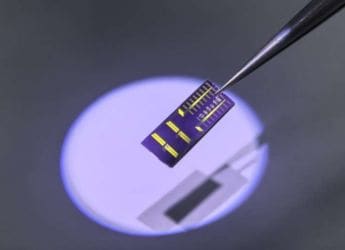- Home
- Science
- Science News
- Sensor to Track Medication Intake in 30 Seconds Using Sweat Developed: Details
Sensor to Track Medication Intake in 30 Seconds Using Sweat Developed: Details
The device has already been tested on people, including one person on a lithium treatment regimen.

Photo Credit: Jialun Zhu and Shuyu Lin
The sensor (pictured) uses a water-based gel containing glycerol to detect charged lithium particles
Researchers have developed a small, touch-based sensor that can detect the level of lithium in a person's body using their sweat. The device can give out results in less than 30 seconds and does not require a visit to a clinic. The right level of lithium in the body can help in controlling the symptoms of mental health issues including bipolar disorder and depression. Updates on the lithium level in the body allow health care providers to keep a track of whether a patient has been taking the medication as prescribed or not.
The presently available methods of keeping a track of medication are invasive and have their own drawbacks. While blood tests offer a picture of the progress of medication, the process is invasive and time-consuming. Pill counters, on the other hand, can't assure the measure of actual medication intake. However, with this new device, researchers attempt to address this limitation using sweat.
The results of the device's performance were presented at the fall meeting of the American Chemical Society (ACS) on August 21
The electrochemical sensing device uses a water-based gel containing glycerol to detect charged particles of lithium in the sweat which usually is present in minute amounts.
“Although it may not be visible, the human body constantly produces sweat, often only in very small amounts,” said Shuyu Lin, PhD, a postgraduate student researcher who co-presented the work with graduate student Jialun Zhu.
The gel created a controlled environment for the electronic portion of the sensor. To trap the lithium ions after they passed through the gel, the researchers used an ion-selective electrode. The accumulating ions generate a difference in electrical potential compared with a reference electrode.
This difference was then used to ascertain the concentration of lithium present in sweat.
The device has already been tested on people, including one person on a lithium treatment regimen. The researchers recorded this person's lithium levels before and after taking the medication. The results showed that the measurement fell were close to those derived from saliva, which prior research has shown to accurately measure lithium levels.
Though the sensor is still in the preliminary testing phase, the researchers aim to incorporate it into a larger, yet-to-be-designed system that provides visual feedback to the provider or the patient.
Get your daily dose of tech news, reviews, and insights, in under 80 characters on Gadgets 360 Turbo. Connect with fellow tech lovers on our Forum. Follow us on X, Facebook, WhatsApp, Threads and Google News for instant updates. Catch all the action on our YouTube channel.
Related Stories
- Samsung Galaxy Unpacked 2025
- ChatGPT
- Redmi Note 14 Pro+
- iPhone 16
- Apple Vision Pro
- Oneplus 12
- OnePlus Nord CE 3 Lite 5G
- iPhone 13
- Xiaomi 14 Pro
- Oppo Find N3
- Tecno Spark Go (2023)
- Realme V30
- Best Phones Under 25000
- Samsung Galaxy S24 Series
- Cryptocurrency
- iQoo 12
- Samsung Galaxy S24 Ultra
- Giottus
- Samsung Galaxy Z Flip 5
- Apple 'Scary Fast'
- Housefull 5
- GoPro Hero 12 Black Review
- Invincible Season 2
- JioGlass
- HD Ready TV
- Laptop Under 50000
- Smartwatch Under 10000
- Latest Mobile Phones
- Compare Phones
- OnePlus 15R
- Realme Narzo 90x 5G
- Realme Narzo 90 5G
- Vivo S50 Pro Mini
- Vivo S50
- OPPO Reno 15c
- Redmi Note 15 5G
- Redmi Note 15 Pro 5G
- Asus ProArt P16
- MacBook Pro 14-inch (M5, 2025)
- Infinix Xpad Edge
- OnePlus Pad Go 2
- OnePlus Watch Lite
- Just Corseca Skywatch Pro
- Acerpure Nitro Z Series 100-inch QLED TV
- Samsung 43 Inch LED Ultra HD (4K) Smart TV (UA43UE81AFULXL)
- Asus ROG Ally
- Nintendo Switch Lite
- Haier 1.6 Ton 5 Star Inverter Split AC (HSU19G-MZAID5BN-INV)
- Haier 1.6 Ton 5 Star Inverter Split AC (HSU19G-MZAIM5BN-INV)

















